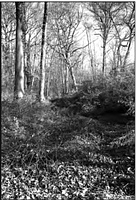Ghost Roads in Palisades: The First in an Occasional Series on the Lanes and Byways of Palisades
Last night, grey clouds blushing pink from the city lights raced across a not quite full moon as my husband and I walked up Washington Spring Road in the dark, carrying a flashlight as our only protection against whatever might be out there. Sheila Asch had advised me when we first moved here to carry a flashlight because not every lane had streetlights. You could stumble or worse in the pitch black. Possibly even get lost! Possibly never to be seen again. We had moved to Brigadoon, so we had learned—it could happen.
The next allusion to vanishing roads came from Kathy Sykes who showed me the strip of land on the other side of a stream coursing through the backyards of the property owners north of Washington Spring Road. She said that over the years there had been confusion about who the owners were so it tended to be neglected by landowners on the far side of the stream. Tradition has it that, before the Revolutionary War, this strip of land at the foot of the Woods Road cliff was once part of Washington Spring Road, and plunged straight down to the ferry. When General Washington used Palisades and Snedens Landing as a staging area for the New York front against the British, he is said to have found it an easier go for his horses and artillery by changing the direction of the road to a meandering zigzag. This feels intuitively correct, that General Washington would want an easier climb, but wouldnʼt everyone else, too, especially since they had been carting goods to and from the pier for many decades before he arrived on the scene? And why would the road be on that side of the stream where flooding would be more severe?
I went to the library to consult William Sargent Gilman, Jr.ʼs book Local History and discovered that Mr. Gilman had struggled with the same questions. He wrote in 1897 that in the days of sloop navigation on the river, and probably in the previous century, the road from the landing was very steep, coming up directly from the dock. He was uncertain whether the road traveled the north or the south side of the spring at Corbett Lane known as Washington Spring and was unable to find a map showing the fabled route. However, his studies of the Serviss map of 1874 and his knowledge of the area, in particular, the intriguing position of the former Hagen house, (118 Washington Spring Road), purported to be the oldest house in Palisades, angling away from the present day road, suggested to him that the road once curved in front of this house before it began its descent down the hill. If this were the case, the road would have crossed the stream somewhere east of 82 Washington Spring Road to meet up with the pier. A straight line can be drawn from the crest of the hill at the Hagen house to the landing, confirming the plausibility of the tradition, if not proving it. He thought the change probably had taken place in the early 19th century or the late 18th century, after Washington had left, but did not explain.
On page 294 of Alice Gerardʼs book Historic Houses of Palisades one finds a most intriguing map that to a fevered mind could provide evidence of this change in routing. It is hand drawn by General Washington ʼs geographer, Robert Erskine, and shows very clearly Closter Road passing through the uplands of Palisades and east to the river with what looks like a dotted line going directly over the palisades escarpment to the landing and a heavier solid line showing the new detour. As oneʼs temperature returns to normal, one has to say those dots are more likely hatchings meant to indicate the steep slope of the cliffs. Not to mention this map was available to Mr. Gilman, who would have known better than I!
As my husband and I walked back home, we passed familiar stone pillars of missing gates, overgrown with vines, standing guard at the entrance to lanes long gone. One comes upon them like wild animals whose eyes gleam in the dark. We shined our flashlight on them. They did not flee, but hinted at our past and beckoned to us to enter.



